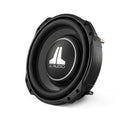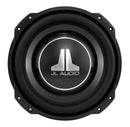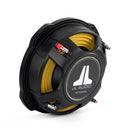











Summary
Building on the core technology of our TW5 thin-line subwoofers, the new TW3’s deliver a powerful combination of shallow mounting depth and excursion capability. In fact, they are capable of greater excursion than the W3v3’s.
To allow this remarkable feat to be achieved, JL Audio’s patented thin-line woofer technology compresses the architecture of the TW3’s using a “concentric tube” structure built into the injection-molded cone body. This structure supports the voice coil and a full annular spider, while permitting the placement of the large motor structure further forward in the speaker than with conventional designs.
TW3’s are optimized for small enclosures and offer our tab-ear mounting design to maximize cone area within their mounting footprints. We know you’re going to love working with these amazing subwoofer drivers.
Deep, powerful and accurate JL Audio bass is now possible in more applications than ever.
- Very shallow mounting depth (3.25 / 3.50 Inches)
- No pole vent: permits mounting close to rear wall of enclosure.
- Very small sealed enclosure volume requirements
- Very long linear excursion capability (0.60 In / 15.2 mm, one-way)
- DMA-optimized motor designs
- Patented “concentric tube” architecture
- Patented “floating cone attach method” technology
- Cast alloy frame
- Injection molded, mica-filled polypropylene cone
- Rubber surround
- Aluminum-alloy dust cap and rear cap with JL Audio logo
- Precision-built in USA at JL Audio’s Miramar, Florida factory
Overview

Dynamic Motor Analysis - DMA Optimized Motor
Summary:
JL Audio's proprietary Dynamic Motor Analysis system is a powerful suite of FEA-based modeling systems, first developed by JL Audio in 1997 and refined over the years to scientifically address the issue of speaker motor linearity. This leads to vastly reduced distortion and faithfully reproduced transients... or put simply: tight, clean, articulate bass.
Detailed Information:
Since 1997, JL Audio has been at the forefront of Finite Element Analysis-based modeling of loudspeaker motors and suspensions. This research is aimed at decoding what we refer to as the "Loudspeaker Genome"... a project aimed at understanding the true behavior of loudspeakers under power and in motion. A major component of this integrated system is DMA (Dynamic Motor Analysis). Starting with the 15W3v3 and the W7 Subwoofers in the late 1990's and early 2000's, DMA has played an important role in the design of all JL Audio woofers sold today, including our component woofers.
DMA is a Finite Element Analysis (FEA)-based system, meaning that it takes a large, complex problem, breaks it down into small solution elements for analysis and then assembles the data to form an accurate, "big-picture" solution. DMA's breakthrough is that it actually considers the effects of power through the coil as well as coil/cone position within the framework of a time-domain analysis. This gives us a highly accurate model of a speaker's actual behavior under real power, something that the traditional Thiele-Small models or other low power measurements cannot do. Because DMA does not rely on a steady-state model, it is able to consider shifts in the circuit elements being analyzed. These modeling routines are intense, requiring hours to run for a whole speaker.
DMA is able to analyze the real effects of fluctuating power and excursion upon the magnetic circuit of the motor, specifically the dynamic variations of the "fixed" magnetic field. This delivers intensely valuable information compared to traditional modeling, which assumes that the "fixed" field produced in the air gap by the magnet and the motor plates is unchanging. DMA not only shows that this "fixed" field changes in reaction to the magnetic field created by current flowing through the voice coil, but it helps our engineers arrive at motor solutions that minimize this instability. Analyzing this behavior is critical to understanding the distortion mechanisms of a speaker motor and sheds light on the aspects of motor design that determine truly linear behavior:
- Linear motor force over the speaker's operational excursion range
- Consistent motor force with both positive and negative current through the coil
- Consistent motor force at varying applied power levels
Our ability to fully analyze these aspects of motor behavior allows our transducer engineers to make critical adjustments to motor designs that result in extremely linear, highly stable dynamic loudspeaker motor systems.
The payoff is reduced distortion, improved transient performance and stellar sound quality.

Engineered Lead-Wire System (U.S. Patent #7,356,157)
Summary:
Carefully engineered lead-wire design and attachments ensure controlled, quiet lead-wire behavior under the most extreme excursion demands.
Detailed Information:
Managing the lead-wires on a long-excursion woofer is one of the trickier aspects of its mechanical design. To address this, many long-excursion woofers today rely on a simple solution that weaves the lead-wires into the spider (rear suspension) of the driver.
The biggest problem with this approach is that spider limiting behavior plays a hugely important role a woofer's performance. Lead-wires that are attached or woven into the spider material can alter the spider's "stretching" behavior. The tinsel wire naturally has less 'give' than the fabric material of the spider leading to asymmetrical spider behavior and non-uniform stress distribution around the spider circumference. The wire attachment points can also cause localized pulling and tearing forces at the spider's excursion limits. As such, longevity becomes a major concern and makes the woven-in design less than ideal for very long-excursion designs.
While a traditional 'flying lead' design does not compromise spider linearity or radial stability, it creates its own challenges on a long-excursion woofer. Managing the 'whipping' behavior of the wire and making sure it does not contact the cone or spider is one challenge. Another is ensuring that the leads do not short one another or the frame of the woofer.
To overcome these issues, JL Audio's engineered flying lead-wires work in conjunction with carefully engineered entry and exit support structures molded into the terminals and the voice coil collar. Some models also feature jacketed lead-wires to further reduce the likelihood of shorting and fatigue. The result is flawless high-excursion lead-wire behavior, with outstanding reliability and none of the compromises inherent to a woven-in lead wire system. Building woofers this way requires much more labor and parts complexity than the simpler woven-in approach, but the payoff is in reduced distortion, reduced mechanical noise and improved reliability.

Tab-Ear Frame Design
Summary:
This frame design feature facilitates mounting the subwoofer driver in tight spaces.
Detailed Information:
By employing a tab-ear mounting system, the driver's overall outside dimensions are reduced, permitting it to be mounted in a space that is very similar to that required by the next smaller round woofer frame.
In this example, the “Tab-Ear” frame design allows a 13TW5 13.5-inch driver to fit in a space only slightly larger than a conventional 12-inch woofer requires (only 0.44 in. / 11.2 mm bigger)


Concentric Tube Suspension (U.S. Patent #5,734,132 & #6,095,280)
Summary:
Our patented Concentric Tube Suspension™ technology delivers unprecedented excursion in a low-profile woofer.
Detailed Information:
The biggest challenge in any low-profile woofer design is to create enough mechanical clearance for the speaker to generate enough excursion to meet its output and low-frequency extension goals. Since these goals were very ambitious in the development of JL Audio's low profile woofers, achieving them required development of a new suspension architecture.
JL Audio's patented solution employs a molded structure which spans over the edge of the motor system, supporting the spider on the outside of the motor's boundaries and the large diameter voice coil on the inside. The large diameter voice coil permits the magnet to sit inside it, rather than surrounding the coil as is typical in most woofers.

The concentric tube structure and the elimination of a conventional top-plate helps us place the motor system higher up into the cone body's space to further compress depth, while still permitting excellent mechanical excursion.

Precision Built in U.S.A.
Summary:
JL Audio's Miramar, Florida loudspeaker production facility is one of the most advanced in the world.
Detailed Information:
At a time when most audio products are built overseas, JL Audio’s commitment to in-house loudspeaker production continues to grow. All W7’s, W6’s, TW5’s, TW3's, W3v3’s and some of our ZR products. We also build our Marine Speaker Systems, Home Subwoofers, Stealthbox® products and the vast majority of our enclosed subwoofer systems in Florida.
To pull this off in a competitive world market, our production engineering team has created one of the world’s most advanced loudspeaker assembly facilities. This commitment to state-of-the-art technology allows our highly skilled workforce to efficiently build JL Audio products to extremely high quality standards.
While it is also feasible to build good quality products overseas (and we do build some of our products in Europe and Asia), it can be challenging when the product’s technology is innovative or complex. Since most of our premium loudspeakers incorporate proprietary, patented technologies requiring specific assembly techniques, we prefer that the people who design them have close access to the people manufacturing them.
Specifications
General Specifications

- Continuous Power Handling (RMS) 400 W
- Recommended RMS Amplifier Power 200 - 400 W
- Nominal Impedance (Znom) Dual 4 Ω
Physical Specifications

- Nominal Diameter 10 in / 250 mm
- Overall Diameter (A) A1: 11.2 in / 284 mm
- A2: 10.5 in / 267 mm
- Mounting Hole Diameter (B) 9.625 in / 244 mm
- Bolt Hole Circle (C) 10.5 in / 267 mm
- Magnet Diameter (D) 5.1 in / 130 mm
- Mounting Depth (E) 3.25 in / 83 mm
- Driver Displacement 0.019 cu ft / 0.54 L
- Net Weight 10.1 lb / 4.6 kg
Parameters
- Free Air Resonance (Fs) 32.30 Hz
- Electrical “Q” (Qes) 0.656
- Mechanical “Q” (Qms) 11.35
- Total Speaker “Q” (Qts) 0.62
- Equivalent Compliance (Vas) 0.700 cu ft / 19.82 L
- One-Way Linear Excursion (Xmax)* 0.6 in / 15.2 mm
- Reference Efficiency (no) 0.2300%
- Efficiency (1 W / 1 m)** 82.10 dB SPL
- Effective Piston Area (Sd) 56.532 sq in / 0.0365 sq m
- DC Resistance (Re)*** 9.036 Ω
* Xmax specifications are derived via one-way voice coil overhang method with no correction factors applied.
** For parallel-wired voice coils, divide "Re" by 4. All other specifications remain the same.
*** Re (DC resistance) is measured with the voice coils in series, for parallel-wired specification divide Re by 4. All other specifications remain the same.
Sealed Enclosure Specifications

- Wall Thickness 0.75 in / 19 mm
- Front Baffle Thickness 0.75 in / 19 mm
- Volume (net int.) 0.50 cu ft / 14.16 L
- External Width (W) 16 in / 406 mm
- External Height (H) 13.875 in / 352 mm
- External Depth (D) 6.5 in / 165 mm
- F3 40.09 Hz
- Fc 50.04 Hz
- Qtc 0.96
Enclosure Notes
* The enclosure recommendations listed above are external dimensions which assume the use of 0.75 in (19 mm) thick material. If you are using 0.625 in (16 mm) thick material, subtract 0.25 in (6) from each dimension. Do not use any material with a thickness of less than 0.625 in (16 mm) as this may compromise the rigidity of the enclosure.
* All enclosure volumes listed above are net internal volumes! Driver displacement, port displacement and brace displacement must be added to obtain the final gross internal volume. All enclosure dimensions above have already taken this into account.
* When using multiple subwoofers in a common enclosure you will need to recalculate the enclosure and port dimensions. For assistance please contact your authorized JL Audio dealer or JL Audio Technical Support.
* We recommend the use of this speaker in a bi-amplified system using high-quality satellite speakers and a high-quality amplifier. We do not recommend the use of this subwoofer with a passive crossover (coil), as this type of device will adversely affect performance.
* All specifications are subject to change without notice.
Safety Notice
Prolonged exposure to sound pressure levels in excess of 100dB can cause permanent hearing loss. This high-performance speaker can exceed this level. Please exercise restraint in its operation in order to preserve your ability to enjoy its fidelity.
When installing a subwoofer in your vehicle, it is extremely important to secure the enclosure firmly. We recommend bolting the enclosure through the metal of the floorpan or the frame of the vehicle with large diameter washers for reinforcement. If an enclosure is not firmly attached, it can become a projectile in a collision. This is particularly important in a hatchback, station wagon, sports utility vehicle, or van.
Customer Reviews
Payment & Security
Your payment information is processed securely. We do not store credit card details nor have access to your credit card information.

